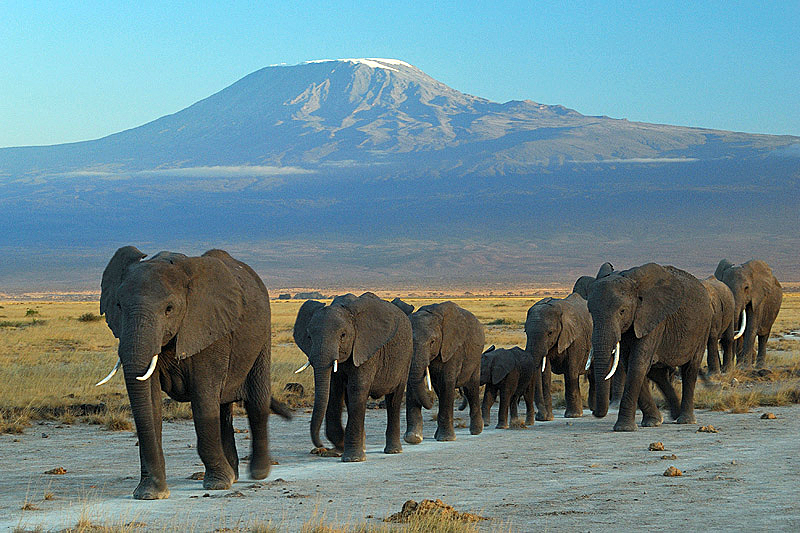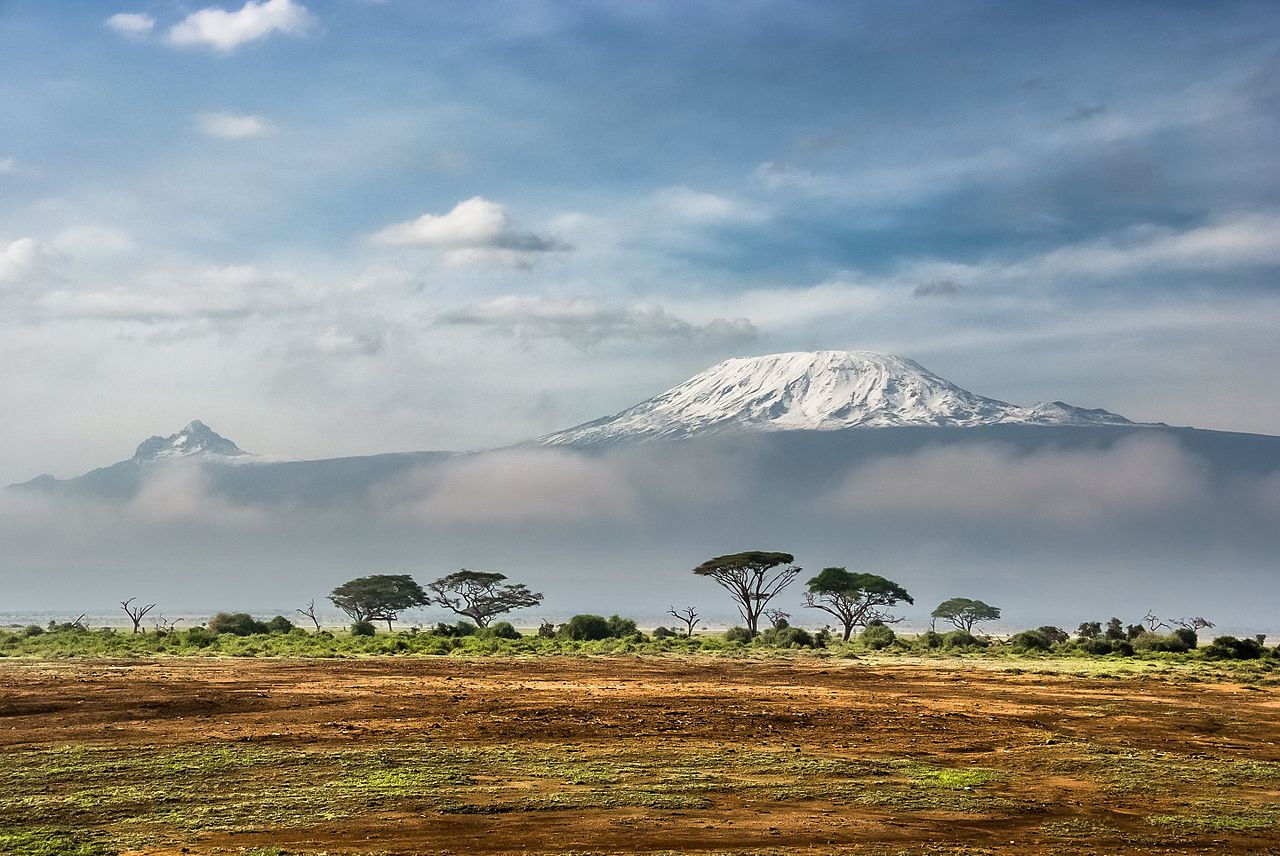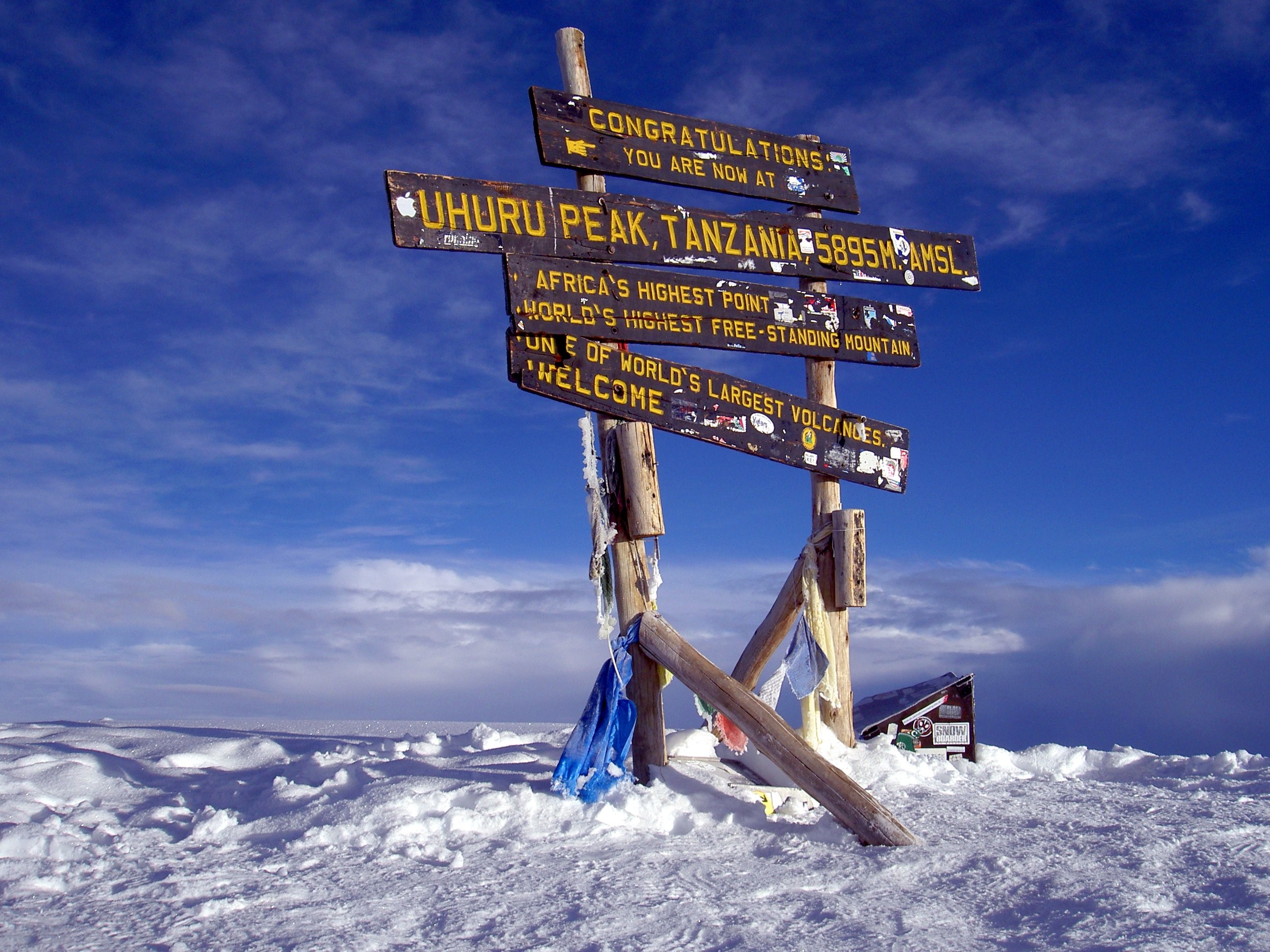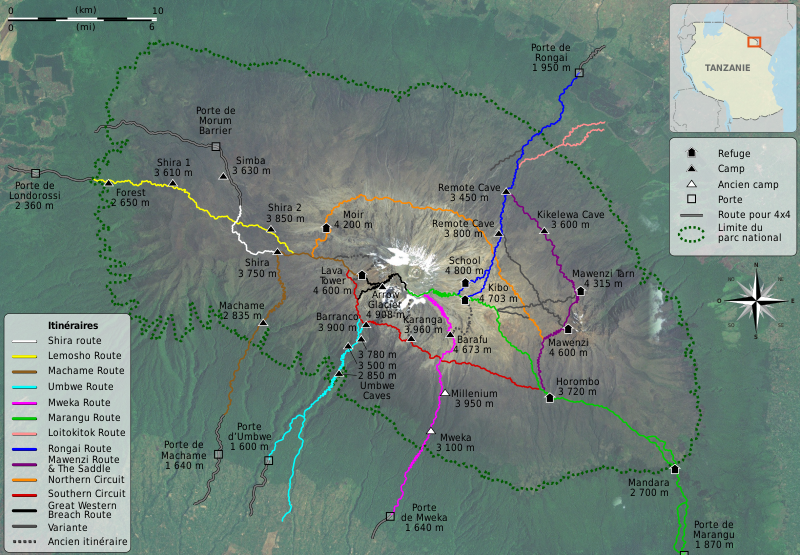Facts about Mount Kilimanjaro in Tanzania:
Mount Kilimanjaro is a dormant volcano located in Kilimanjaro Region of Tanzania. It has three volcanic cones: Kibo, Mawenzi, and Shira. It is the highest mountain in Africa and the highest single free-standing mountain above sea level in the world: 5,895 metres (19,341 ft) above sea level and about 4,900 metres (16,100 ft) above its plateau base. It is the highest volcano in Africa and the Eastern Hemisphere.
Kilimanjaro is the fourth most topographically prominent peak on Earth. It is part of Kilimanjaro National Park and is a major hiking and climbing destination.
The name "Kilimanjaro" has deep historical and cultural significance. It is believed to have originated from the Chagga people, the indigenous ethnic group residing around the mountain in northern Tanzania. The Chagga are one of the largest ethnic groups in Tanzania, and their language, Chaga or Kichagga, is still spoken in the region today.

Meaning of the Name "Kilimanjaro":
The name "Kilimanjaro" is thought to have two possible etymological origins:
"Kilema Kyaro":
One interpretation is that "Kilimanjaro" is a combination of the Chagga words "Kilema" and "Kyaro." "Kilema" means "difficult" or "impossible," and "Kyaro" means "caravan" or "journey." Therefore, "Kilimanjaro" can be interpreted to mean "Difficult Journey" or "Impossible Journey," likely referring to the challenges and hardships faced by the local people in the mountainous terrain.
"Njaro Njaro":
Another possible interpretation is that "Kilimanjaro" is derived from the Swahili words "Njaro Njaro," which can be translated as "shining" or "white-capped." This name could be a reference to the mountain's snow-capped peak, which glistens in the sunlight and is visible from a distance, earning it the nickname "The Roof of Africa."

Local Names for Mount Kilimanjaro in Local Languages:
Before the arrival of Europeans in the region, the local communities living around and near the mountain referred to it by various names in their respective languages:
Chaga (Kichagga):
The Chagga people, who are native to the slopes of Kilimanjaro, call the mountain "Kibo" (pronounced kee-bo). Kibo refers specifically to the snowy peak of the mountain. For the Chagga, the mountain holds significant cultural and spiritual importance. They believe that their ancestors' spirits reside on the summit, and they conduct rituals and ceremonies to honor the mountain's spiritual significance.
Maasai (Maa Language):
The Maasai people, who inhabit the area to the south of Kilimanjaro, call the mountain "Ol Doinyo Oibor" (also spelled Ol Doinyo Orok). Translated from the Maa language, it means "White Mountain" or "Mountain of Whiteness," again referring to the snow-capped peak. For the Maasai, Kilimanjaro is a sacred site, and they consider it the dwelling place of their god Enkai.
Why Kilimanjaro is Africa's Most Popular Mountain Climbing Destination
Rising majestically from the African plains, Mount Kilimanjaro in Tanzania stands as the tallest peak on the continent and one of the world's most iconic natural wonders. Its awe-inspiring beauty, unique ecological diversity, and relatively accessible routes have earned it the title of Africa's most popular mountain climbing destination.
Kilimanjaro's popularity can be attributed to several factors. Firstly, its summit, Uhuru Peak, stands at an impressive elevation of 5,895 meters (19,341 feet) above sea level, making it the highest point on the African continent. This makes it a highly coveted destination for climbers seeking to conquer one of the Seven Summits, which comprises the highest peak on each of the seven continents.
Secondly, Kilimanjaro's diverse ecological zones provide climbers with a unique and ever-changing landscape during their ascent. The mountain encompasses five distinct climatic zones: the lush rainforest, the heath and moorland, the alpine desert, the arctic zone, and the summit's permanent ice cap. This ecological variety creates an unparalleled climbing experience that attracts adventure enthusiasts from all over the world. Furthermore, the fact that Kilimanjaro does not require technical climbing skills or the use of specialized equipment like ropes and ice axes makes it accessible to a wide range of climbers, from experienced mountaineers to novices. However, it is essential to recognize that the altitude and potential altitude sickness are still significant challenges that climbers must prepare for.

Climbing Routes and Starting/Ending Points
Kilimanjaro offers several climbing routes, each varying in duration, difficulty, and scenery. The following are some of the most popular routes:
a) Marangu Route (The Coca-Cola Route)
Starting Point: Marangu Gate (1,860 meters / 6,102 feet)
Ending Point: Marangu Gate
Description: This is the oldest and most established route on Kilimanjaro. It is often called the "Coca-Cola" route due to the availability of bottled beverages along the way. The Marangu Route is the only one with hut accommodation, making it a preferred choice for those seeking a more comfortable climb.
b) Machame Route (The Whiskey Route)
Starting Point: Machame Gate (1,800 meters / 5,905 feet)
Ending Point: Mweka Gate (1,640 meters / 5,380 feet)
Description: The Machame Route is known for its diverse and stunning scenery. It offers an opportunity to acclimatize properly and is considered a more challenging route compared to Marangu. Campsites along the way include Machame Camp, Shira Camp, Barranco Camp, Karanga Camp, and Barafu Camp.
c) Lemosho Route
Starting Point: Londorossi Gate (2,100 meters / 6,890 feet)
Ending Point: Mweka Gate
Description: The Lemosho Route is a longer and more remote option, providing excellent opportunities for acclimatization. It offers stunning panoramic views and is less crowded compared to other routes. The route includes camps like Forest Camp, Shira Camp, Barranco Camp, Karanga Camp, and Barafu Camp.
d) Rongai Route
Starting Point: Rongai Gate (1,950 meters / 6,398 feet)
Ending Point: Marangu Gate or Mweka Gate (depends on the chosen variation)
Description: The Rongai Route is the only route that approaches Kilimanjaro from the north. It is a less crowded and drier route, offering a unique perspective of the mountain. The camps on this route are Simba Camp, Kikelewa Camp, Mawenzi Tarn Camp, and Kibo Hut.
e) Shira Route:
Starting Point: Shira Gate
Ending Point: Uhuru Peak
Climbing Route: Shira - Lava Tower - Barranco - Barafu - Uhuru Peak
The Shira Route begins on the western side of Kilimanjaro and approaches the peak from the Shira Plateau. It offers stunning views and is less crowded than some other routes, making it a preferred choice for seasoned climbers seeking a quieter experience. However, it requires climbers to be well-acclimatized due to its relatively rapid ascent.
Camp Names: Simba Camp, Moir Hut, Barranco Camp, Karanga Camp, Barafu Camp
e) Mweka Route:
Starting Point: Mweka Gate
Ending Point: Uhuru Peak
Climbing Route: Mweka - Barafu - Uhuru Peak
The Mweka Route is often used for descending the mountain as it provides a direct route down the southern face. It is the quickest way down but is rarely used for ascending due to its limited acclimatization opportunities and steep terrain.
Camp Names: Mweka Camp
f) Umbwe Route:
Starting Point: Umbwe Gate
Ending Point: Uhuru Peak
Climbing Route: Umbwe - Barranco - Barafu - Uhuru Peak
Known as the most challenging and steepest route, the Umbwe Route is recommended only for experienced climbers who are confident in their abilities to tackle difficult terrain. It offers breathtaking views but requires strong physical endurance and excellent acclimatization.
Camp Names: Umbwe Camp, Barranco Camp, Barafu Camp
g) Mawenzi Tarn Route:
Starting Point: Rongai Gate
Ending Point: Mawenzi Tarn Camp
Climbing Route: Rongai - Mawenzi Tarn Camp
The Mawenzi Tarn Route takes a more gradual approach on the northeastern side of Kilimanjaro. It provides the opportunity to explore the stunning Mawenzi Peak before ascending to the Mawenzi Tarn Camp. However, this route does not lead to Uhuru Peak and is not commonly used for summit attempts.
Camp Names: Simba Camp, Kikelewa Camp, Mawenzi Tarn Camp
h) Loitokitok Route:
Starting Point: Loitokitok Gate
Ending Point: School Hut
Climbing Route: Loitokitok - School Hut
The Loitokitok Route, also known as the Eastern Route, is less popular and less well-established compared to other routes. It approaches the mountain from the Kenyan side and requires special permits. Climbers considering this route should be prepared for challenging conditions and a remote wilderness experience.
Camp Names: School Hut
i) Northern Circuit Route:
Starting Point: Lemosho Glades
Ending Point: Uhuru Peak
Climbing Route: Lemosho - Moir Hut - Buffalo Camp - School Hut - Uhuru Peak
The Northern Circuit Route is the longest and most scenic route, offering panoramic views and excellent acclimatization opportunities. It circles around the northern slopes of Kilimanjaro and is preferred by climbers seeking a more leisurely and less crowded experience.
Camp Names: Forest Camp, Shira Camp 1, Shira Camp 2, Moir Hut, Buffalo Camp, School Hut, Barafu Camp
j) Southern Circuit Route:
Starting Point: Shira Gate
Ending Point: Mweka Gate
Climbing Route: Shira - Barranco - Barafu - Uhuru Peak - Mweka
The Southern Circuit Route combines parts of the Shira and Mweka routes, offering a diverse range of landscapes and scenery. It is an excellent option for climbers who wish to experience both the western and southern slopes of the mountain.
Camp Names: Simba Camp, Barranco Camp, Karanga Camp, Barafu Camp, Mweka Camp

Fastest, Easiest, and Most Difficult Routes
Fastest Route: The fastest route to the summit of Kilimanjaro is the Marangu Route, also known as the "Coca-Cola" route. This is because it has a shorter itinerary, usually completed in 5 to 6 days. However, while it is the fastest, it also has the lowest summit success rate due to the rapid ascent, leading to inadequate acclimatization. The Mweka Route is also fairly fast, but it is typically used for descending rather than ascending.
Easiest Route: The Marangu Route is also often considered the easiest route due to its well-maintained trail, hut accommodation, and gradual ascent on some sections. However, it is essential to emphasize that Kilimanjaro is a challenging climb, and the term "easiest" should not be taken lightly.
Most Difficult Route: The most difficult route is often considered to be the Western Breach route, which involves more technical climbing and poses higher risks. This route is less popular due to its steep and challenging nature, and it is only recommended for experienced climbers. The Umbwe Route is also fairly difficult and challenging route due to its steep and demanding terrain.
Flora and Fauna
Kilimanjaro's diverse ecological zones offer a wide array of flora and fauna as climbers progress through the different landscapes:
Flora:
The lower slopes of Kilimanjaro are covered in lush rainforests, with various plant species such as ferns, mosses, and towering trees, including camphor, cedar, and juniper.
As climbers ascend, the vegetation transitions into heath and moorland, characterized by heather, lobelia, and giant groundsel.
The alpine desert zone features sparse plant life, such as drought-resistant grasses and hardy shrubs.
Fauna:
Kilimanjaro is home to a variety of wildlife, including elephants, buffalo, leopards, and various antelope species. However, these animals are rarely seen at higher altitudes due to human presence.
Smaller mammals like the black-and-white colobus monkey, blue monkey, and olive baboon inhabit the lower forested areas.
Birdwatchers will be delighted to encounter unique avian species, such as the Abbot's starling and the silvery-cheeked hornbill.
Temperature at the Top and Bottom, and Snowfall
At the bottom of Kilimanjaro, the temperatures are generally warm, with the lowlands experiencing a tropical climate. In contrast, the summit is characterized by freezing temperatures, especially during the night.
At the Base (Starting Point): The temperatures at the base of Kilimanjaro vary throughout the year but generally range from 20 to 30°C (68 to 86°F).
At the Summit (Uhuru Peak): The temperatures at the summit can plummet to as low as -20°C (-4°F) during the day and -30°C (-22°F) or even colder during the night.
Snowfall on Kilimanjaro is a rare and remarkable phenomenon, given its proximity to the equator. However, the mountain's permanent ice cap has been shrinking over the years due to climate change, and it is estimated that the glaciers may disappear entirely within the next few decades.
Best Months to Climb Kilimanjaro, Busiest and Less Busy Months
The best time to climb Kilimanjaro is generally during the dry seasons, which offer clearer skies and more favorable climbing conditions:
Best Months: January to March and June to October are considered the best months to climb Kilimanjaro. The weather is generally drier during these periods, reducing the likelihood of rain and cloud cover.
Busiest Month: July is typically the busiest month for climbing Kilimanjaro. Many climbers prefer this time due to school vacations and the expectation of favorable weather conditions.
Less Busy Months: April to May is the "long rains" season, and November to December is the "short rains" season. These months see fewer climbers due to higher chances of rain and less predictable weather.
Countries with the Highest Number of Climbers
The United States is the country that brings in the most climbers to Mount Kilimanjaro. American adventurers, seeking to conquer the tallest peak on the African continent, contribute significantly to the mountain's popularity.
Regarding African climbers, the majority of them come from Kenya. Kenya, being a neighboring country, often sees a good number of its citizens venturing to Tanzania to challenge themselves on the slopes of Kilimanjaro.
Conclusion
Mount Kilimanjaro's status as Africa's most popular mountain climbing destination is well-deserved. Its remarkable elevation, diverse ecological zones, accessible climbing routes, and abundant flora and fauna make it an unforgettable experience for climbers from around the world. However, climbing Kilimanjaro requires proper preparation, physical fitness, and respect for the mountain's unique environment. By choosing the right route and timing their climb wisely, adventurers can revel in the breathtaking views and sense of accomplishment that comes with reaching Uhuru Peak, the "Roof of Africa."
Tanzanian and African Perspectives:
For Tanzanians, including the Chagga and other ethnic groups living near Kilimanjaro, the mountain is not only a geographical landmark but also an integral part of their cultural identity and heritage. It is revered as a symbol of strength, resilience, and spiritual significance. The mountain holds traditional and historical significance in local folklore, and its various local names reflect the deep-rooted connection that the indigenous communities have with their natural surroundings.
From an African perspective, Kilimanjaro is a source of pride and a representation of Africa's natural wonders. It stands as a reminder of the continent's diverse landscapes and rich cultural heritage. Mount Kilimanjaro's recognition as the highest peak in Africa has drawn attention to the region and contributed to its significance as a popular destination for climbers and adventurers from all over the world.
In conclusion, Kilimanjaro's name holds a combination of cultural, historical, and geographical significance. It is a symbol of Africa's natural beauty and the profound relationship between its people and their environment. The local names given to the mountain by the Chagga and Maasai communities reflect their deep understanding and respect for the mountain's grandeur and spiritual importance. As the highest free-standing mountain in the world, Mount Kilimanjaro will continue to captivate the imagination of people worldwide while remaining an integral part of Tanzania's cultural heritage.